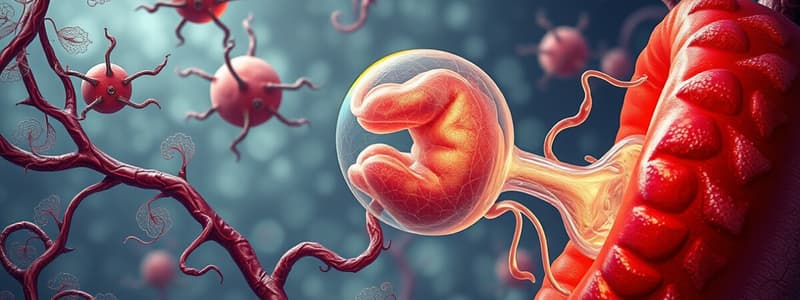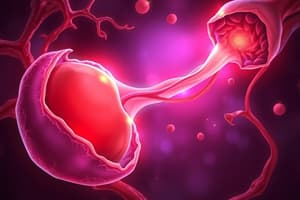Podcast
Questions and Answers
When does the mesoblastic phase of hematopoiesis begin?
When does the mesoblastic phase of hematopoiesis begin?
19th day of embryonic development
What cells give rise to hematopoietic stem cells in the mesoblastic phase?
What cells give rise to hematopoietic stem cells in the mesoblastic phase?
Cells from the aorta-gonad mesonephros region
At what gestational weeks does the hepatic phase begin?
At what gestational weeks does the hepatic phase begin?
4-5 gestational weeks
The thymus becomes a major site of T-cell production during the hepatic phase.
The thymus becomes a major site of T-cell production during the hepatic phase.
Which blood cells are primarily produced in the liver during the hepatic phase?
Which blood cells are primarily produced in the liver during the hepatic phase?
What marks the start of the medullary phase?
What marks the start of the medullary phase?
What is the myeloid to erythroid ratio by 21 weeks of gestation?
What is the myeloid to erythroid ratio by 21 weeks of gestation?
What are the primary lymphoid tissues?
What are the primary lymphoid tissues?
Yellow marrow is hematopoietically active.
Yellow marrow is hematopoietically active.
Where is red marrow located in adults?
Where is red marrow located in adults?
What function does the spleen serve?
What function does the spleen serve?
What are the main functions of lymph nodes?
What are the main functions of lymph nodes?
The largest lymphoid organ in the body is the ______.
The largest lymphoid organ in the body is the ______.
Flashcards are hidden until you start studying
Study Notes
Hematopoiesis Overview
- Hematopoiesis is the process of blood cell formation, occurring in distinct phases.
- Phases include Mesoblastic, Hepatic, and Medullary, transitioning during embryonic development into adulthood.
Mesoblastic Phase
- Initiates at the 19th day of embryonic development post-fertilization.
- Hematopoietic stem cells (HSCs) arise from aorta-gonad mesonephros region.
- Mesodermal cells differentiate into primitive erythroblasts.
- Angioblasts form future blood vessels surrounding the yolk sac.
Hepatic Phase
- Begins at 4-5 gestational weeks, characterized by clusters of erythroblasts, granulocytes, and monocytes.
- Decline in primitive hematopoiesis from the yolk sac; lymphoid cells emerge.
- Liver hematopoiesis peaks at the 3rd month of fetal life.
- Thymus becomes the primary site for T-cell production; kidneys and spleen produce B-cells.
- Megakaryocyte production starts; spleen shifts focus from granulopoiesis to lymphopoiesis.
- Detectable levels of fetal hemoglobin (HbF), hemoglobin A (HbA), and hemoglobin A2 (HbA2) may be observed.
Medullary Phase
- Commences at the 5th month; myeloid activity becomes evident.
- Myeloid to erythroid ratio reaches adult level of 3:1 by 21 weeks.
- Bone marrow becomes the main site for hematopoiesis by the end of the 6th month.
- Detectable levels of erythropoietin, G-CSF, GM-CSF, fetal Hgb, HbA2, and adult Hgb are present.
Adult Hematopoietic Tissue
- Composed of primary lymphoid tissues: Bone marrow and Thymus.
- Secondary lymphoid tissues include: Spleen, Lymph nodes, and Gut-associated lymphoid tissue.
Bone Marrow
- Located within cortical bone cavities, consists of trabecular bone resembling honeycomb.
- Two types: Red (hematopoietically active) and Yellow (inactive, mainly adipocytes).
- Red marrow found in sternum, skull, scapulae, vertebrae, ribs, pelvic bones, and proximal long bones.
Red Marrow
- Contains extravascular cords with blood cell lineages, stem cells, adventitial cells, and macrophages.
- Normoblasts cluster near vascular sinuses; megakaryocytes are positioned for platelet release.
- Myeloid cells develop deeper within the cords.
Liver and Spleen Function
- Liver increases bilirubin conjugation and iron storage in hemolytic anemias; removes damaged RBCs from circulation.
- Capable of extramedullary hematopoiesis during bone marrow shutdown.
- Spleen, the largest lymphoid organ, acts as a blood filter and synthesizes IgM in germinal centers; stores platelets.
Methods of RBC Removal in Spleen
- Culling: Phagocytosis and degradation of senescent RBC organelles.
- Pitting: Splenic macrophages remove inclusions or damaged membranes from circulating RBCs.
Lymph Nodes
- Located along lymphatic capillaries, bean-shaped (1-5 mm), appearing in chains.
- Functions:
- Formation of new lymphocytes in germinal centers.
- Processing specific immunoglobulins (Ig).
- Filtering particulate matter, debris, and bacteria from lymph fluid.
Thymus
- Develops from endodermal origins; essential for T-cell maturation.
Studying That Suits You
Use AI to generate personalized quizzes and flashcards to suit your learning preferences.




